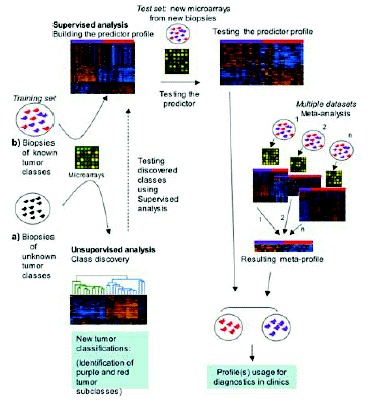From: Microarrays for Cancer Diagnosis and Classification

NCBI Bookshelf. A service of the National Library of Medicine, National Institutes of Health.

Analysis of microarray data to discover new tumor classification and to build gene predictors for cancer diagnosis. a) For class discovery, biopsies, which we hypothesize belong to different tumor classes (black biopsies), are analyzed by unsupervised methods to see the global similarities and differences between them at the molecular level. In this case, the biopsies formed two main clusters (green and blue) depending on their gene expression, which means that there are indeed 2 different classes within our samples. b) To build a gene predictor profile for cancer diagnosis we analyze samples that belong to the 2 classes we want to distinguish (purple and red). The supervised analysis will give the list of genes that are differentially regulated in one class with respect to the other. This list of genes will form the predictor profile. A new group of samples of known classes (test set) is analyzed to test the validity of the predictor. For this, the gene predictor profile is used to assign test set samples to one of the classes. Gene profiles created in different laboratories can be combined in a meta-profile. Resulting profiles are applied for diagnostics.
From: Microarrays for Cancer Diagnosis and Classification

NCBI Bookshelf. A service of the National Library of Medicine, National Institutes of Health.